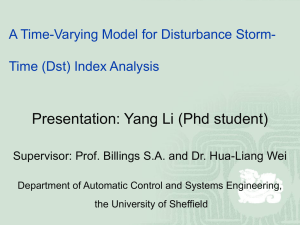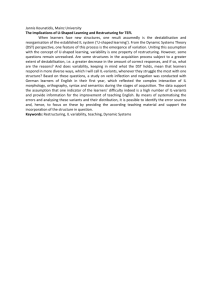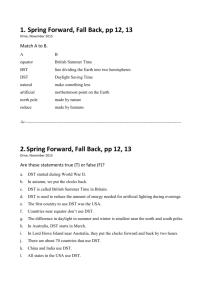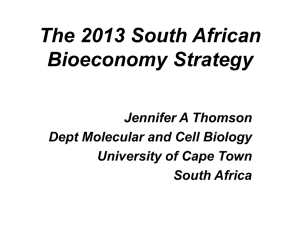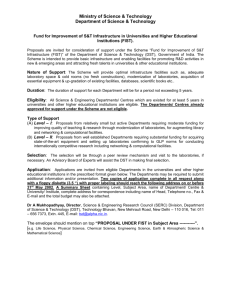Cospar98 - UCLA Institute for Geophysics and Planetary Physics
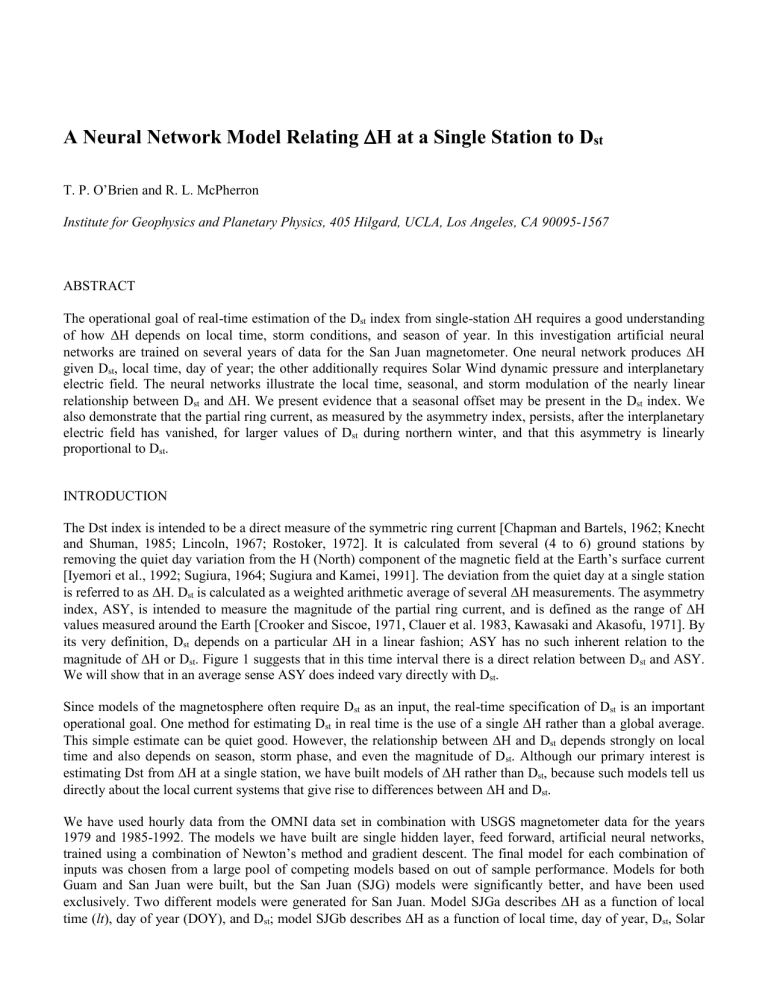
A Neural Network Model Relating
H at a Single Station to D
st
T. P. O’Brien and R. L. McPherron
Institute for Geophysics and Planetary Physics, 405 Hilgard, UCLA, Los Angeles, CA 90095-1567
ABSTRACT
The operational goal of real-time estimation of the D st
index from single-station
H requires a good understanding of how
H depends on local time, storm conditions, and season of year. In this investigation artificial neural networks are trained on several years of data for the San Juan magnetometer. One neural network produces
H given D st
, local time, day of year; the other additionally requires Solar Wind dynamic pressure and interplanetary electric field. The neural networks illustrate the local time, seasonal, and storm modulation of the nearly linear relationship between D st
and
H. We present evidence that a seasonal offset may be present in the D st
index. We also demonstrate that the partial ring current, as measured by the asymmetry index, persists, after the interplanetary electric field has vanished, for larger values of D st
during northern winter, and that this asymmetry is linearly proportional to D st
.
INTRODUCTION
The Dst index is intended to be a direct measure of the symmetric ring current [Chapman and Bartels, 1962; Knecht and Shuman, 1985; Lincoln, 1967; Rostoker, 1972]. It is calculated from several (4 to 6) ground stations by removing the quiet day variation from the H (North) component of the magnetic field at the Earth’s surface current
[Iyemori et al., 1992; Sugiura, 1964; Sugiura and Kamei, 1991]. The deviation from the quiet day at a single station is referred to as
H. D st
is calculated as a weighted arithmetic average of several
H measurements. The asymmetry index, ASY, is intended to measure the magnitude of the partial ring current, and is defined as the range of
H values measured around the Earth [Crooker and Siscoe, 1971, Clauer et al. 1983, Kawasaki and Akasofu, 1971]. By its very definition, D st
depends on a particular
H in a linear fashion; ASY has no such inherent relation to the magnitude of
H or D st
. Figure 1 suggests that in this time interval there is a direct relation between D st
and ASY.
We will show that in an average sense ASY does indeed vary directly with D st
.
Since models of the magnetosphere often require D st
as an input, the real-time specification of D st
is an important operational goal. One method for estimating D st
in real time is the use of a single
H rather than a global average.
This simple estimate can be quiet good. However, the relationship between
H and D st
depends strongly on local time and also depends on season, storm phase, and even the magnitude of D st
. Although our primary interest is estimating Dst from
H at a single station, we have built models of
H rather than D st
, because such models tell us directly about the local current systems that give rise to differences between
H and D st
.
We have used hourly data from the OMNI data set in combination with USGS magnetometer data for the years
1979 and 1985-1992. The models we have built are single hidden layer, feed forward, artificial neural networks, trained using a combination of Newton’s method and gradient descent. The final model for each combination of inputs was chosen from a large pool of competing models based on out of sample performance. Models for both
Guam and San Juan were built, but the San Juan (SJG) models were significantly better, and have been used exclusively. Two different models were generated for San Juan. Model SJGa describes
H as a function of local time ( lt ), day of year (DOY), and D st
; model SJGb describes
H as a function of local time, day of year, D st
, Solar
Wind dynamic pressure (P sw
), and interplanetary electric field (VB s
). The out of sample rms error for
SJGa is 11.2 nT, for SJGb 10.5 nT. Throughout this discussion, D st
,
H, and ASY will be presented in nT, P sw
in nPa, and VB s
in mV/m.
After training the networks on real data, we fed them artificial data so that we could isolate interesting behavior. In particular, we tend to vary only one of the inputs (e.g. local time) while holding the others fixed. This allows us to get a clear idea of how one particular parameter effects the system. Although it is physically impossible for D st
to remain constant for a day while the Earth rotates beneath the current systems in the magnetosphere, our empirical model allows us to simulate this situation. Since we can nT
ASY
D st
Fig. 1. The variations in D st
and ASY are correlated in time and magnitude. The substorm activity in the first disturbed period seems to prevent D st
from recovering.
In the second period, the recovery is more rapid. arbitrarily specify the local time we are interested in, we can, in effect, have San Juan at all longitudes simultaneously. We are not making any dynamic simulations, but merely varying parameters that we typically associate with time which are, in fact, spatial. That is, local time is merely a measure of the spatial location of the station relative to the Earth-Sun line, and season is just a measure of the position of the Earth in its orbit, and consequently, the orientation of its rotation axis to the Solar equator.
SEASONAL EFFECTS ON THE MAPPING OF
H TO D st
First, we will investigate the seasonal effects in the
H-D st
mapping
. We will show that the offset in the best linear fit to the neural network output for D st
below –40 nT varies in a regular way with season. We will also show that the variation in the slope of this relation with season is less pronounced. We choose to make the linear fit to D st
-
40 nT because the
H-D st
relationship is extremely linear in this regime. Although the neural network produces
H as a function of D st
, we have inverted the relation and created least-squared-error linear fits of D st
as a function of
H. In Figure 2 left, the horizontal contour lines show us that the seasonal dependence of the slope is insignificant, except at 1800 hours, where the change is limited to the range 0.7-0.8. In contrast the local time variation of the slope is much larger ranging between 0.8-1.4 late in the year. Local time and seasonal changes in the offset plotted in the right panel are comparable covering a range –10 to +15 nT. This offset is not large compared to the Dst index during a large storm, but it is large enough to seriously effect estimates of the recovery rate late in a storm.
There are two possible causes of this dependence: incorrect quiet days and genuine seasonal dependence. The first could arise from the standard method used in calculating the quiet days for the D st
index. The
H values are the hourly deviations from the quiet day field of the Earth. The D st
index is the weighted average of these
H values.
We use the standard D st
index, but calculate our own hourly
H values. The standard technique and the technique we employ for calculating the quiet day are essentially the same, but we use a longer time window in defining the secular variation of the Earth’s magnetic field, and we use a slightly different technique to remove storm effects.
While the differences in technique could give rise to some systematic difference in our
H and those used to calculate the standard D st
, there is no reason to suggest that the differences between these two techniques would give rise to a coherent seasonal variation. The second possible cause of the seasonal dependence could be the result of some interplay between the geomagnetic coordinate system and the day-night asymmetry in the ionospheric conductivity, which is tied to the geographic coordinates. This could be confirmed by building a similar
H model for a Southern Hemisphere station, but has not been done at this time.
THE DISAPPEARANCE OF THE PARTIAL RING CURRENT DURING STORM RECOVERY
The next issue we will address is the disappearance of the partial ring current in the storm recovery phase. It is generally believed that that the partial ring current always vanishes when the interplanetary magnetic field B z
turns northward, or, equivalently, VB s
= 0 [see examples in Kawasaki and Akasofu, 1971]. Because we can hold all the
Fig. 2. For the slope of the linear D st
-
H relationship, it is clear that the local time dependence dominates. For the offset, however, the seasonal variation is significant, weighing in at nearly 10 nT peak to peak for some local times.
Fig. 3. In northern summer (DOY 151), the asymmetry drops below 20 nT when VB s
shuts off. In the winter (DOY 331), it persists at more than 40 nT until D st
recovers to –40 nT. other variables constant and only change the local time, we can simulate ASY as the range of
H we get out of our model if we apply it to 24 hours of local time while holding all other parameters fixed. In Figure 3, we have done this for several values of VB s
, several values of D st
, and 2 days of the year. Surprisingly, we find that during northern winter, the simulated ASY index can be quite large for VB s
= 0. For example at D st
= -40 nT, the ASY is about 40 nT at DOY 331 (late November) for VB s
= 0. However, for the same conditions on DOY 151 (late May), the simulated ASY index is less than 20 nT. This suggests that somehow, during northern winter, the partial ring current does not decay soon after the IMF B z
turns northward, but that during northern summer the decay is more immediate.
In Figure 3, it is also apparent that the asymmetry determined by the neural network depends strongly on the magnitude of D st
. Figure 4 shows that the
H values at different local times spread with stronger D st
. This spread is the asymmetry, and its dependence on D st
is linear for both the main and recovery phases. A linear dependence of the ASY is essential to making a good model of D st
given only one
H. Figure 4 also demonstrates that the neural network model is fitting a meaningful difference in the behavior at different local times. This result was so surprising we checked it by plotting the WDC-C2 ASY-H versus SYM-H at one-minute resolution. There is an obvious linear dependence between the two with a correlation coefficient ~ 0.7
The persistence of ASY beyond the time when VB s
shuts off can most likely be explained by one of two mechanisms. First, it is possible that the asymmetry persists because of a neutral flywheel effect where the neutrals provide an inertia, which keeps the partial ring current system going after the driver has shut off. Second, it is possible that a local ionospheric current is actually contaminating the
H measurements, and that this current is related directly to the storm intensity, and therefore D st
. The latter would be consistent with the observed seasonal variation in the less accurate Guam models.
DISCUSSION
We have built a neural network model of
H from D st
, local time, day of year, and Solar Wind conditions. With this model, we have shown that a significant seasonal offset exists in the linear relation between
H and D st
, which
SJGb vs D st
(P sw
= 3) (VB s
= 0) (DOY = 331) SJGb vs D st
(P sw
= 3) (VB s
= 3) (DOY = 331)
20
0
20
0
-20 -20
-40
+,-. lt = 1800
H = 1.22*D st
+ -1.78
-40
+,-. lt = 1800
H = 1.21*D st
+ -17.49
-60
-80
-60
-80 o,-- lt = 0600
H = 0.84*D st
+ -4.08
-100 -100 o,-- lt = 0600
H = 0.72*D st
+ 1.64
-120 -120
-140 -140
-160
-100 -50 0 50
-160
-100 -50 0 50
D st
D st
Fig. 4. The
H-D st
relation is shown for recovery phase (VB s
= 0) and main phase (VB s
= 3). The dashed and dashed-dotted line represent neural network fits, and the ‘o’ and ‘+’ indicate real data at approximately the same values of D st
, VB s
, etc., at dawn and dusk, respectively. The
H-D st
relation is linear for D st
below -40 nT. The spread (ASY) grows linearly below this point. suggests that D st
itself may have a seasonal offset. We have also shown the partial ring current, as measured by the
ASY index, does not shut off immediately when VB s
drops to zero, but, at least in parts of the year, persists until
D st
itself decays. The first of these results suggests either an error in the calculation of the quiet day or a seasonally dependent storm-time feature of the ionosphere. The second result suggests either a neutral flywheel providing inertia to the partial ring current or, again, a seasonally dependent storm-time feature of the ionosphere. The possibility of a seasonally dependent storm-time feature of the ionosphere could be tested by the investigation of the
H-D st
relationship for a Southern Hemisphere ground station.
ACKNOWLEDGEMENTS
We would like to thank the USGS and NGDC and WDC-C2 for providing the data that we have used in this analysis. This work is supported by NSF grant ATM 96-13667
REFERENCES
Chapman, S., and J. Bartels, Geomagnetism, Vol 1, Clarendon Press, Oxford, 1962.
Clauer, C.R., R.L. McPherron, and C. Searls, Solar wind control of the low-latitude asymmetric magnetic disturbance field, J. Geophys. Res., 88(A4), 2123-2130, 1983.
Crooker, N.U., and G. Siscoe, A tudy of the geomagnetic disturbance field asymmetry, Radio Sci., 6, 495-501,
1971.
Iyemori, T., T. Araki, T. Kamei, and M. Takeda, Mid-latitude geomagnetic indices ASY and SYM (provisional),
Data Analysis Center for Geomagnetism and Space Magnetism, Faculty of Science, Kyoto University, Kyoto,
Japan, 1992.
Kawasaki, K., and S.-I. Akasofu, Low-latitude DS component of geomagnetic storm field, J. Geophys. Res.,
76(10), 2396-2405, 1971.
Knecht, D.J., and B.M. Shuman, The geomagnetic field, in Handbook of Geophysics and the Space Environment, edited by A.S. Jursa, pp. 4-1 to 4-37, Air Force Geophysics Laboratory, Hanscom Field, MA, 1985.
Lincoln, J.V., Geomagnetic Indices, in Physics of Geomagnetic Phenomena, edited by S.M.a.W.H. Campbell, pp.
67-100, Academic Press, New York, 1967.
Rostoker, G., Geomagnetic indices, Rev. Geophys. Space Phys., 10(4), 935-950, 1972.
Sugiura, M., Hourly values of equatorial Dst for the IGY, Ann. Int. Geophys. Year, 35, 9-45, 1964.
Sugiura, M., and T. Kamei, Equatorial Dst index 1957-1986, ISGI Pubnlications Office, Saint-Maur-des-Fosses,
France, 1991.

